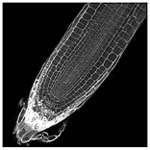Scientists find direct line from development to growth

It may seem intuitive that growth and development somehow go together so that plants and animals end up with the right number of cells in all the right places. But it is only now that scientists at the Duke Institute for Genome Sciences & Policy have gotten some of the first insights into how this critical coordination actually works in a plant.
The answer is surprisingly simple.
A well-known developmental protein called Short-root has been found to directly control the activity, in both time and space, of other well-known genes involved in cell division.
"It's a remarkably straightforward answer," said Philip Benfey, director of the IGSP's Center for Systems Biology. "Considering the level of complexity that is so often found in biology, this is simplicity itself."
The researchers report their findings on July 1 in the journal Nature.
Benfey's group and others have studied the molecular-level events that determine what particular cells in Arabidopsis plants will become in considerable detail. Those events involve genetic partners Short-root and Scarecrow along with a couple of microRNAs (see http://www.physorg.com/news96213206.html and http://www.physorg.com/news191068798.html).
Researchers also have a pretty good understanding of the intrinsic factors that allow cells to go through their cycle and divide into two daughter cells. "What was missing was a connection between the two," said Rosangela Sozzani, a postdoctoral researcher in Benfey's lab and first author of the new study.
To shed light on that connection, Sozzani and her collaborators combined a number of experimental techniques and technologies to produce a dynamic, genome-wide view of the genetic events that Short-root and its partner Scarecrow set into motion within a single type of cell. At the very same time that cells divide, Short-root and Scarecrow switch on the gene cyclin D6, they report. Cyclin D6 is one of a family of genes that govern cell growth and division.
Benfey says the discovery in plants has immediate practical relevance given the central role of plants to human life, in the form of "food, feed, fuel and fiber." It's also likely that the "logic" behind plants' growth and development will carry over to other species, perhaps even our own. In fact, he and Sozzani note, animals including humans have cyclin D6 too.
"It's not just molecules," Benfey said. "There are evolutionary relationships. Once these fundamental processes got worked out, they are likely to have been kept around."
More information: The paper Spationtemporal regulation of cell-cycle genes by SHORTROOT links patterning and growth is published in Nature on July 1, 2010-06-29.
Provided by Duke University















